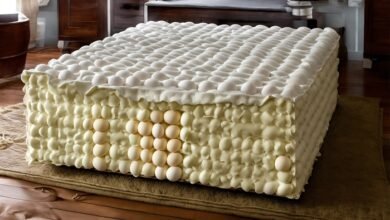Transform Your Space: A Comprehensive Guide to Home Goods Decor

Introduction
When it comes to creating a warm and inviting home, home goods decor plays a crucial role. From selecting the right furniture to choosing the perfect accessories, every element of home goods decor contributes to the overall ambiance of your living space. This blog post will explore various aspects of home goods decor, offering insights and ideas to help you enhance your home’s aesthetic. Whether you’re looking to update a single room or redecorate your entire home, understanding the principles of home goods decor can make the process more enjoyable and successful.
The Basics of Home Goods Decor
Before diving into specific styles and trends, it’s important to understand the basics of home goods decor. Home goods decor encompasses a wide range of items, including furniture, textiles, lighting, artwork, and accessories. Each of these elements should work together harmoniously to create a cohesive look. When selecting home goods decor, consider factors such as color schemes, material choices, and the overall theme of your space. By starting with a clear vision, you can ensure that your home goods decor reflects your personal style while maintaining functionality and comfort.
Choosing the Right Furniture for Your Home
Furniture is a cornerstone of home goods decor and serves as the foundation for your space’s design. When selecting furniture, think about both aesthetics and functionality. For example, a stylish sofa that provides ample seating and comfort is a key piece of home goods decor in your living room. Similarly, a well-designed dining table can serve as the focal point of your dining area. Consider the size of your space, the layout, and how you intend to use each room when choosing furniture. Remember, the right furniture can elevate your home goods decor and create a welcoming atmosphere.
Exploring Popular Home Goods Decor Styles
One of the most exciting aspects of home goods decor is exploring different styles. Whether you prefer a modern, minimalist look or a cozy, rustic feel, there’s a home goods decor style that suits your taste. Popular styles include contemporary, traditional, bohemian, and Scandinavian, each offering unique design elements and decor ideas. For instance, if you gravitate towards a modern look, consider sleek furniture with clean lines and neutral colors. On the other hand, a bohemian style embraces eclectic patterns, vibrant colors, and a mix of textures. Understanding these styles will help you curate home goods decor that resonates with your personality.
Incorporating Textiles in Home Goods Decor
Textiles are a vital component of home goods decor that can significantly impact the look and feel of your space. Rugs, curtains, cushions, and throws not only add comfort but also introduce color, pattern, and texture to your decor. When choosing textiles, consider the overall color scheme of your room and select fabrics that complement it. For example, a bold patterned rug can become a statement piece in a neutral living room, while soft, plush cushions add warmth and coziness. By carefully selecting textiles, you can enhance your home goods decor and create a more inviting environment.
The Role of Lighting in Home Goods Decor
Lighting is another essential element of home goods decor that often gets overlooked. Proper lighting can dramatically change the ambiance of a room, making it feel more open, cozy, or intimate. When planning your home goods decor, think about different types of lighting, such as ambient, task, and accent lighting. Ambient lighting provides overall illumination, while task lighting is essential for specific activities like reading or cooking. Accent lighting, on the other hand, highlights particular areas or objects, adding depth and interest to your decor. Incorporating a variety of lighting sources will ensure that your home goods decor is both functional and visually appealing.
Accessorizing with Home Goods Decor
Accessories are the finishing touches of home goods decor that bring personality and character to your space. Items like vases, candles, picture frames, and decorative objects can enhance the overall theme of your decor. When selecting accessories, consider their placement and how they complement the other elements in the room. For example, a well-placed vase with fresh flowers can brighten up a coffee table, while a collection of framed photos adds a personal touch to a hallway. Accessories in home goods decor should be carefully chosen to enhance the aesthetic without overwhelming the space.
Creating a Focal Point in Home Goods Decor
Every room benefits from a focal point, a central piece of home goods decor that draws the eye and sets the tone for the rest of the space. This could be a striking piece of artwork, a bold piece of furniture, or an architectural feature like a fireplace. Creating a focal point is essential in guiding the flow of the room and ensuring that the space feels balanced. In the living room, a statement sofa or a large, colorful painting can serve as the focal point. In the bedroom, a well-dressed bed with layered textiles and accent pillows can take center stage. By establishing a focal point, you can elevate your home goods decor and create a cohesive design.
Staying on Budget with Home Goods Decor
Decorating your home with quality home goods decor doesn’t have to break the bank. There are plenty of ways to stay on budget while still achieving a stylish and cohesive look. Start by prioritizing key pieces that will have the most impact, such as a statement sofa or a beautiful area rug. You can then supplement these with more affordable accessories and decor items. Thrift stores, online marketplaces, and sales events are great places to find budget-friendly home goods decor. Additionally, consider DIY projects to create unique decor items that reflect your personal style. With careful planning, you can create a stunning space without overspending.
Seasonal Trends in Home Goods Decor
Home goods decor is ever-evolving, with new trends emerging each season. Keeping up with these trends can help you refresh your space and keep it feeling current. For example, spring might bring pastel colors and floral patterns, while autumn introduces warmer tones and cozy textures. Incorporating seasonal trends into your home goods decor doesn’t mean you need to overhaul your entire space; small updates like changing throw pillows, adding a seasonal wreath, or swapping out curtains can make a big difference. By embracing seasonal trends, you can keep your home goods decor looking fresh and stylish throughout the year.
Conclusion
Home goods decor is more than just a way to make your space look attractive—it’s about creating an environment that reflects your personality and meets your functional needs. From choosing the right furniture and textiles to incorporating lighting and accessories, every element of home goods decor plays a role in transforming your home into a place of comfort and beauty. By understanding the basics, exploring different styles, and staying mindful of your budget, you can create a home that is both stylish and inviting. Whether you’re redecorating a single room or your entire home, these tips will help you achieve a cohesive and personalized look that you’ll love for years to come.
FAQs
1. What is home goods decor?
Home goods decor refers to the various elements, including furniture, textiles, lighting, and accessories, used to enhance the aesthetic and functionality of a home.
2. How can I choose the right home goods decor for my space?
Choosing the right home goods decor involves considering your personal style, the size and layout of your space, and how you intend to use each room.
3. What are some popular styles in home goods decor?
Popular styles in home goods decor include contemporary, traditional, bohemian, and Scandinavian, each offering unique design elements and ideas.
4. How can I stay on budget when decorating with home goods decor?
To stay on budget, prioritize key pieces that have the most impact, shop at thrift stores, and consider DIY projects for unique and affordable decor.
5. How can I incorporate seasonal trends into my home goods decor?
Incorporate seasonal trends by making small updates, such as changing throw pillows, adding seasonal accessories, or swapping out textiles to refresh your space.




